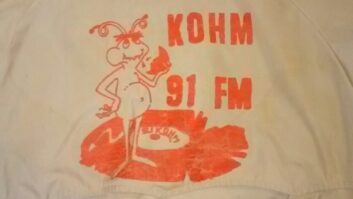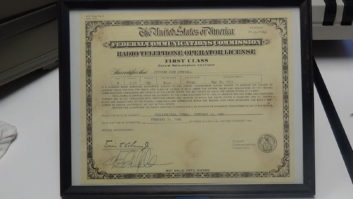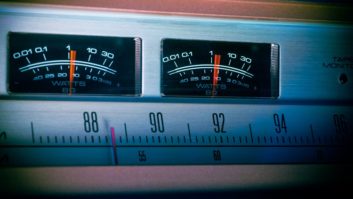FM “CONGESTION”
FM congestion will be even worse than indicated in this article (“Will FM Band Grow More Congested,” Dec. 16) as translator and full-power NCE applicants and permittees from 2003, 2007 and 2010 windows go on the air. This past year Michi Bradley with RECnet and Dave Solomon with Low Power Advocacy Group filed petitions requesting more power for low-power broadcasters, up to 250 watts, to provide improved coverage.
After the 2016 translator moves and the 2017 FM translator windows for AM broadcasters, there will be very little spectrum left in populated areas for more powerful LPFMs. Having an LPFM major mod window for power increases will be “moot” if most LPFMs will not be able to participate because of the crowded spectrum.
John O. Broomall, Sr.
Senior Consultant
Christian Community Broadcasters
Canton, Ga.
TWO BIRDS, FOUR STONES
The congestion dilemma is why many of us continue to strongly advocate for repurposing the TV Channel 5 and 6 bandwidth for FM radio broadcasting. Between present and future FM translators, boosters and LPFMs, as well as the full-power “rimshot” FMs that were allowed to move in to large and major markets, before the commission came down with its “no rural to urban move-ins,” interference will absolutely arise in already crowded urban markets.
So with the very lengthy complaint process mentioned by Mr. Vernier, the full-power FM owners, who invested millions of dollars to acquire their stations and operate them, will now have the affirmative burden of defending the integrity of their signals, at a not-inexpensive cost.
My solution includes four components:
1. All AM stations except Class As would be required to move to the Channel 5/6 spectrum by a date certain. Once the move to the new FM frequency is completed, the AM licensee would be required to immediately shut off the FM translator and the old AM station and surrender the licenses for both.
2. All LPFMs would be mandated, by a date certain, to move to the “5/6” bandwidth, with the same requirement to shut off the original signal immediately. Ideally, a defined portion of the 5/6 bandwidth would be reserved for LPFMs.
3. Non-commercial/educational FM stations in the “commercial” 92.1 to 107.9 spectrum would be required to move to the 5/6 bandwidth. As with LPFMs, that portion of the Channel 6 spectrum adjacent to 88.1 FM would be the reserved “real estate” for the relocated and new NCE FM stations. For example, 86.1 to 87.9 MHz could be the portion reserved for NCE FMs.
4. Finally, after the move of all Class B, C and D AM stations to Channel 5/6 spectrum, the cleaned-up AM band would continue to be used exclusively by Class A stations, with two improvements that would address parts of the AM revitalization efforts: Class A stations would be required to upgrade signal power to 100 kilowatts; and a limited number of additional AM Class A frequencies would be created from the former Class B/C/D frequencies, and mandated to operate at 100 kW signal power. The Class A AMs would retain their skywave protection, both as an incentive to continue broadcasting in the AM band and for the public safety purposes they already serve in their respective coverage areas during times of emergency.
Once these steps are completed, the 5/6 bandwidth could be used for other new FM stations, including LPFMs.
Yes, my proposal is significant and “disruptive,” to borrow an economics/business term, but I believe it effectively addresses two major issues facing radio broadcasters today: FM band congestion and improvements to a beleaguered AM band.
Robert E. Lee
Owner/General Manager
QXZ MediaWorks LLC
Phoenix, Ariz.
CONGESTION? POPPYCOCK
Several articles in Radio World and elsewhere have raised concerns of congestion and interference in the FM broadcast band because of the proliferation of new licensed facilities. The fear is that LPFMs and translators will degrade the coverage of existing services. Poppycock.
It’s worth mentioning that the interference model used today by the FCC for FM allocation, with minor changes, is the same one adopted in the middle 1960s. It relies on a combination of distance and terrain and specifies interference ratios for co-channel, first, second and third adjacent frequencies. There is even a distance and ratio requirement that addresses the limitation of the 10.7 MHz I.F. receivers from back when the rules were written.

iStockphoto/fuzzybearphotography Receivers, like every other form of technology, have gotten better in the past 50 years. I have personally parked a rental car directly beneath the Devers tower, east of Houston, Texas, and exactly the 65.6 miles required second adjacent distance away from Houston’s Senior Road tower. The FMs from Senior Road with second adjacents on Devers — predicted to be badly interfered with — come in perfectly. Paint-peeling levels of second adjacent interference gave my rental car radio no problem.
Why? Because receivers no longer have AFC. Remember AFC from the 1960s and 1970s? Your FM receiver compensated for internal drift by developing a DC error voltage that was fed back into the tuning circuits as a correction. But strong adjacent channel signals would often capture this feedback system making it difficult to keep weak signals tuned in. If there was ever a rationale for third adjacent protections, AFC was it.
Now we have receivers that tune digitally using their own precision clock signal as the reference. Because second adjacent spacings and ratios are the same as third adjacent, my bet is both were a function of AFC capture mitigation. I believe we could get rid of both limitations tomorrow and no one would notice. This, alone, would probably add 35 percent more full-power FMs and who knows how many smaller facilities.
First, adjacent spacing and interference ratios are a little more of an issue but not much. The present rules are almost certainly a product of the limited shape factors obtainable with hand-tuned iron-loaded I.F. cans of the 1960s and 1970s. Today you can get a ceramic 10.7 MHz filter with a few dB of loss, already laser trimmed to exact tolerances for about $1.50. Two or three of these babies one after another and your adjacent channel issues are history. Again, reasonable easing of ancient restrictions would add opportunities.
It’s long past time to review the interference rules in light of receiver technology advances made in the past half century. In doing so, we could accommodate current AM licensees and plenty of new faces. And who doesn’t think our industry could use a little new blood?
Frank McCoy
Chief Engineer
Salem Chicago
Forest Lake, Ill.
MARTI MEMORIES
It’s nice to see you folks are paying homage to Mr. Marti and his contributions to the broadcasting industry (“Marti Knew How to Make Connections,” Jan. 6). Now for my two cents.
Radio 101 for me and many of my colleagues who started in the business in the late 1980s included the following:
• After you connect the antenna and turn the unit on, don’t touch the antenna mast! Ouch!
• Common phrase uttered by the on-site talent at a remote: “If you can hear me, dump the audio.” (Who needed cell phones?)
• Have the switch in “transmit” mode … not “standby”! Or no one will hear you!
• Always have extra fuses.
Ken Hawk
President/General Manager
WSNQ(AM)
Saxonburg, Pa.

CREDIT: CHARLES S. FITCHGAZINTA, GAZOUTTA
Excellent article by Paul McLane in Jan. 6 Radio World on George Marti.
Only one tiny error: The picture of the unit is labeled a Marti receiver, when in actuality, it is a M30BT Marti transmitter. This was the vacuum tube version made until it was replaced by the RPT-line of solid state transmitters. It was every bit as rugged as the solid-state versions, and actually a bit easier to work on.
I particularly liked the very last sentence in the article. I wonder how many of today’s broadcasters will ask themselves if their radio stations are really “helping” the community they are in? My guess is few, if any. The ones that do, if they are honest, will not like their answer in most cases. Playing the same 12 songs of their “format” over and over is hardly serving or helping their community.
Jerry Arnold
Retired Director of Engineering
Terre Haute, Ind.
PIRATE REVENUE
Responding to “Pirates Are a State Level Problem, Too”:

iStockphoto/pgaborphotos I have heard advertising being aired on certain pirate stations.
In addition to going after the pirates directly, I don’t know why state/local law enforcement agencies don’t go after businesses that buy ad time on these stations. By simply notifying them that they are supporting an illegal enterprise, I suspect that many would stop buying ad time, thus drying up a major source of funding for the pirates. If a business fails to comply, In addition to stiff fines, a business that continues to support a pirate, could possibly face seizure of assets and/or loss of their operating licenses.
Steve Donnell, WA1YKL
Broadcast Engineer
Newmarket, N.H.










